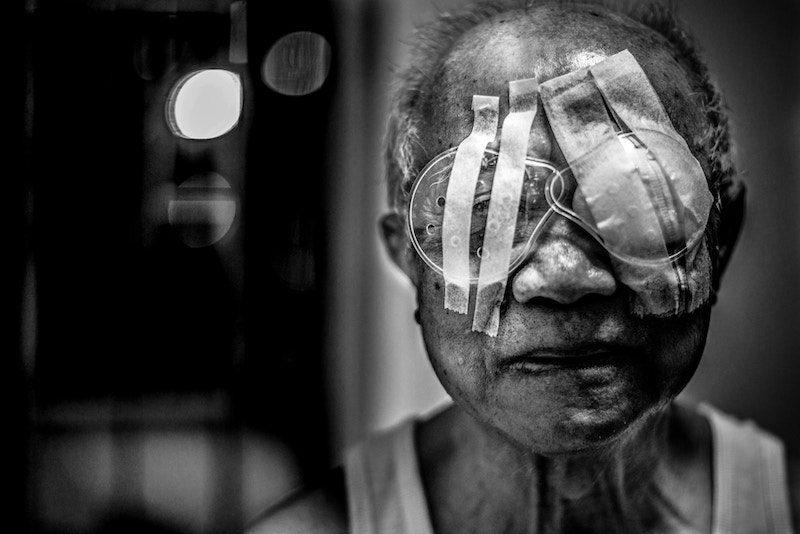
One of the most important choices an author must make concerns Point of View.
In storytelling, people use the term Point of View (or PoV) to refer to different things. We’ve narrowed it down to four definitions:
- The overall perspective from which a story is told
- The scene by scene perspective of a story
- The narrator’s point of view
- Attitude or belief system of the author
Overall perspective
The entire Star Wars saga is, in very general terms, told from the point of view of the two characters that have least status: the robots C-3PO and R2-D2. They are not present in every single scene, but they are part of the overall course of events – and in a ironic tip of the hat to their function of providers of overall point of view, George Lucas has C-3PO relate the entire story so far to the Ewoks in Return of the Jedi.
George Lucas borrowed the idea from Akira Kurosawa’s The Hidden Fortress, which tells a story of generals and princesses from the point of view of two peasants. These two are involved in the action, but understand less about what they see going on than the audience does.(more…)
It’s the way you tell it.
Narrative is the choice of which events to relate and in what order to relate them – so it is a representation or specific manifestation of the story, rather than the story itself. The easy way to remember the difference between story and narrative is to reshuffle the order of events. A new event order means you have a new narrative of the same story.
Narrative turns story into information, or better, into knowledge for the recipient (the audience or reader). Each story event is a unit of knowledge the audience requires.
A narrative is paradox, because it seeks to convey truth by hiding it. A storyteller arranges the items of knowledge in such a way that they are revealed gradually, which implies initially obscuring the truth behind what is told. Such deliberate authorial obfuscation creates a sense of mystery or tension, and creates a desire in the audience to find out what is happening in the story and why. In this sense, a narrative is effectively the opposite of an account or a report.
A report presents information in order to be understood by the audience immediately, as it is being related. A neutral, matter of fact presentation probably maintains a chronology of events. It explains a state of affairs blow by blow, and aims for maximum clarity at every stage. It seeks to convey truth by simply telling it. While the point of a narrative is also that the recipient perceives the truth of the story, in a narrative this truth is conveyed indirectly. Narrative is therefore responsible for how the recipient perceives the story.
In this article we’ll look at
- Story Basics
- The Components of Story
- Text Types That Describe A Story
- Author Choices: Genre and Point of View
- Causality in Narrative
Story Basics
First, let’s state some basics as we understand them here at Beemgee: a story consists of events that are related by a narrator; events consist of actions carried out by characters; characters are motivated, they have reasons for the things they do; there is conflict involved; one and the same story may be told in different ways, that is, have varying narratives.
Note that we are talking here about narrative in the dramaturgical sense – not in the social sense. Like the term “storytelling”, the word “narrative” has become a bit of a buzzword. We are not referring here to open “social narratives” such as “the American narrative”. For the definition and exploration of such collective narratives, see our article in The Bigger ‘Narratives’ of Society. Here, we are pinpointing the use of the term primarily for storytellers creating novels, films, plays, and the like. Such works tend in their archetypal form to be closed narratives with a beginning, a middle, and an end.
A narrative may present the events of the story in linear, that is to say chronological order or not. But the story remains the story – even if it is told backwards.(more…)
Narrative is made of successive events. Not necessarily in the order they occurred.
Narrative is the order in which the author presents a story’s events to the recipient, i.e. the audience or reader. Chronology is the order of these events consecutively in time. Some people use terms from Russian Formalism, Syuzhet and Fabula, to make the distinction.
A chronology usually has less emotional impact than a narrative – essentially a chronology is recounting a report whereas a narrative is telling a story. In a chronology, the plot events are lined up in temporal sequence. You could say “and then” between each event. In a narrative, the emotional effect is closely related to the causality implied by the arrangement of the events. Between each event you could say, “because of that …”.
Narrative therefore carries with it the implication of understanding. The juxtaposition of events, for example, will create associations in the audience’ minds that lead to possibilities of interpretation. While a chronology may explain things, it is in itself inherently neutral. Narrative on the other hand is an arrangement that is usually consciously made by an author who intends something by the particular arrangement, and which, independently of author intention, is subject to interpretation by recipients.
While the convention in most storytelling is linear, i.e. to relate the story’s events consecutively in time (chronologically), we as audiences and storytellers are also very used to narratives that move certain events around. An event may be moved forward, meaning towards the beginning of the narrative, perhaps even to be used as a kick-off. Or possibly events may be withheld from the audience or reader and pushed towards the end, perhaps to create a reveal late in the narrative for a surprise effect – though this technique often feels cheap. Also, an author may use flashbacks to insert backstory events from the past, the past being all relevant events that take place before scene one in the narrative.
As authors, when we begin composing a story, we(more…)
How aware are you of your creative process during writing?
Do you really consciously control what comes out of your fingers onto the page?
Even when writing happens “naturally”, while the words are pouring forth, the author is probably already performing a first level check that precedes the more detached and critical control of rewriting. If you want to make yourself more conscious of this process, consider putting an imaginary parrot on your shoulder every time you sit down to write.
 A parrot?
A parrot?
Well, the creature of your choice. At Beemgee, it’s a parrot.
The parrot reads what you write as you write it and squawks a running commentary into your ear. It might commend a good sentence or it might censure. It might suggest alternative words or phrases. It may like or hate a paragraph.
The parrot has three main hobbyhorses: relevance, surprise, and recognition.
Relevance – (more…)
Some people say they don’t like plot.
For some people, plot is like a dirty word. They prefer their stories to concentrate on character. Or premise. Or language. It is action movies or thrillers by Michael Crichton or Robert Ludlum that have plots.
At Beemgee, we believe that the four pillars that hold a story up are plot, character, meaning, and language – with conflict as girders. Every story, no matter how “good” or “bad”, exhibits all four of these pillars. No story can really go without any one of them. Not to mentions aspects like story world, backstory, or exposition.
We have not found a single work of fiction in any medium or genre that does not have a plot. Ulysses has a plot. The Sound And The Fury has a plot. Even some of the most famous attempts in literary history to shun plot, such as I Am a Cat by Soseki Natsume or Tristram Shandy by Laurence Sterne, did not manage to avoid describing events and characters. Their language might be beautiful and to an extent their premise is the attempt to shun plot. But nonetheless, the stories describe events, things happen in an order, the authors made conscious decisions about the sequence in which to relate the occurrences. To what degree the narrative is structured in these books may be topic for debate, but if we consider plot to be simply a sequence of events, then no story can go entirely without it and still be considered a story.
There is an intimate relationship(more…)

We humans have a built-in predisposition to expect agency.
We look for the person or thing responsible for any action or phenomena we experience; we seek to ascribe “agency” to what we perceive. What this means is that when we notice that something happened, we tend to look for the cause of the event. This probably has a simple evolutionary explanation. If we hear a rustle in the bush behind us, we immediately turn around to see what moved. This reflex is a safety mechanism to detect threats. Before homo sapiens lived in houses, the individuals for whom this reflex worked most efficiently probably lived longer, and thus had better chances of passing on their genes. The point is, we assume that something or someone caused the phenomenon (the rustle) and seek to attribute it to an agent. If we are sitting in our living room and hear a floorboard creak in the hall, we would want to know what caused it too.
This safety mechanism has all sorts of ramifications. It influences(more…)



